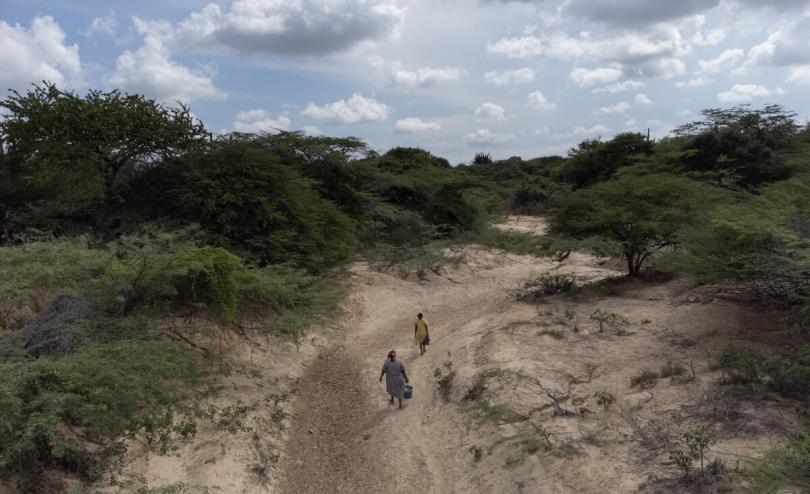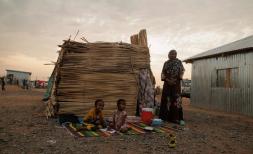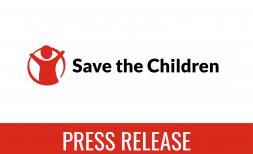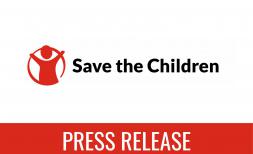“We are exhausted searching for water” - Indigenous children battle hunger, disease and water shortages, as Colombia feels the impact of El Nino

BOGOTA, 12 March 2024 - The devastating impact of the climate crisis on children in Colombia’s largest indigenous group, the Wayuu, is illustrated in this powerful series of photographs by Sony award winning photographer Angela Ponce released by Save the Children.
For centuries, the group have lived off the land, but a series of crippling droughts, soaring temperatures, and the onset of El Nino have devastated the environment which is central to their culture and survival.
The arrival of the weather phenomenon El Nino in Colombia in November 2023[1] has resulted in record high temperatures and low rainfall, further exacerbating drought conditions and putting children's lives at risk. One million children in the country are expected to have been impacted by the effects of El Nino[2], of which Wayuu children are the most vulnerable as they are already suffering from chronic malnutrition and a lack of access to water.
Only one in 30 Wayuu children living in rural areas has access to clean water. [3] The water that is available is often taken from a “jaguey”, a natural aquifer which is reliant on rainwater and shared with livestock. This results in regular occurrences of diarrhoea and other waterborne diseases among children who are forced to drink the water.
Communities now struggle to sow crops because of the prolonged drought, resulting in widespread hunger which threatens the lives of Wayuu children. Last year 70 children lost their lives in the La Guajira region[4], which is an average of five young lives per month. The mortality rate for malnutrition amongst Wayuu children is over six times the national average.
The photographer Angela Ponce spent a week with a small community in the very north of the country in La Guajira meeting with children and their families, capturing daily life, traditions of their ancient culture and the impact of the climate crisis.
The children also learnt to develop their own images relying only on the power of the sun, through the process of “Cyanotype” printing, to symbolise the environmental challenges they face. Each artwork has a distinctive blue hue illustrating the desperate need for water in their community, and the indigenous plants that are vital for their survival.
Iveth, 16, who lives in a small Wayuu community in La Guajria said: “Here, the Wayuu, suffers from the lack of water. It can´t be found, as the weather is changing there aren't seasons anymore."
"We used to go to the pond (for water), but it´s dry and muddy, so it is not healthy for us or the animals to drink. The water is far away, and to walk under this heat.
"Before we had orchards, it rained, the plants grew. We didn´t water the plants, the rain did. Now there´s no rain, the weather has changed so we can´t sow.
“What I wish for the future is my community´s well-being. For them to benefit from things like school, water, sowing… and for us to be healthy and the children don’t die. You know children are dying too often.”
Jamer, 12, is worried by the impact of El Nino and the changing climate. He is exhausted by the constant search for fresh water, often walking for miles in the searing heat of the desert just to find water for his family.
“We are very affected by the El Niño phenomenon because it has not rained…..our crops die, we suffer and then we are forced to look for water from far away where the jagüey (watering hole) is and we get tired with the wheelbarrow. It's hard. What we sow dies, we are exhausted searching for water.
“We need water, what we drink is the polluted water from the pit (jagüey), where the donkeys drink and even urinate.”
Shruti Agarwal, Senior Advisor on Climate Change from Save the Children, said:
“The climate crisis hits the most vulnerable the hardest, and it is children who are paying the highest price for our lack of action.
“Hundreds of millions of people in Indigenous communities across the world, like the children featured in these powerful photographs, are already experiencing the devastating impacts of climate change on their way of life, means of making a living, and fundamental human rights. Even though they contribute the least to greenhouse gas emissions.”
The children involved in the project are all part of a Save the Children programme to educate the Wayuu community about climate change and promote resilience. Save the Children's programmes have empowered the children, teaching them valuable skills such as painting, filming, and addressing vital topics like waste management and deforestation.
Save the Children is raising the alarm that extreme weather events are becoming more frequent in lower income countries as a result of the climate crisis. This means the poorest families in these countries are less able to protect themselves when climate shocks occur in comparison to richer countries. The organisation calls for higher-income countries such as the UK to increase climate funding, to support lower-income countries, who are on the sharp end of the crisis.
Notes to Editors
IMAGES HERE: www.contenthubsavethechildren.org/Package/2O4C2S3MZNYC
INTERVIEWS & BROLL: www.contenthubsavethechildren.org/Package/2O4C2S39MSB2
For more information and media inquiries, please contact Simon Edmunds at s.edmunds@savethechildren.org.uk or +447515855180.




